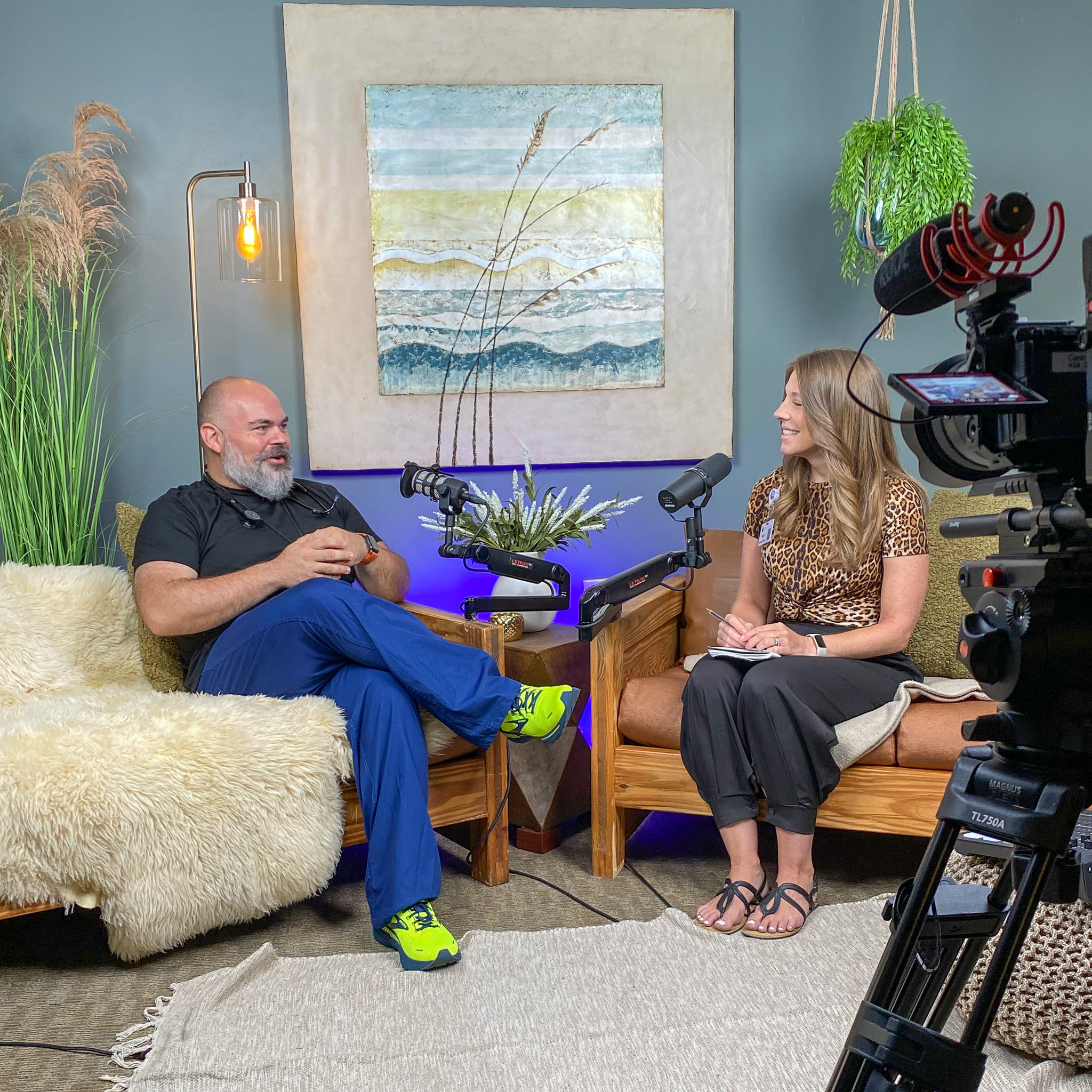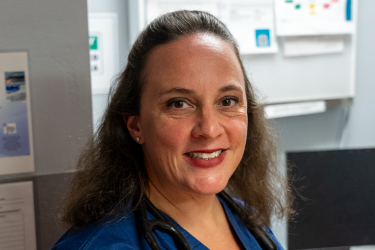They all wear white coats, but the letters that come after their names are different! Have you ever wondered about the different types of doctors who take care of you when you're in the hospital? 🤔🚑
Join Cami Smith and Dr. Travis Engel, Chair of Pediatrics at Centra and a DO himself, as they break down the differences between MDs and DOs in this episode of, “& so much more.”
Together they explore the four tenets of Osteopathic Medicine and explain the extra “tools” in the DO treatment toolkit. Plus, you’ll hear how MDs and DOs team up at Centra, working hand in hand to give our communities a holistic, patient-centered healthcare experience while educating the next generation of medical professionals.
Watch on YouTube
Transcript
Cami Smith:
Hi, and welcome to & So Much More. My name is Cami Smith and I am your host. And I am here with Dr. Travis Engel, who is the Department Chair of Pediatrics. And we are going to be having a discussion today that really impacts all of our patients, because we have so many different kinds of providers here available to patients at Centra Health, and that's for primary care, that's for very specific specialties. So no matter what is bringing you here, there is a care team made up of many kinds of providers, and we've been talking about that. So this episode is a part of a larger series where we talked about what is an APP, what are our advanced practice providers? Like alphabet soup. And so we're going to continue that conversation, and you can go back and listen to that one before you join us today, or just jump in. We're going to talk with Dr. Engel about the difference between a DO and an MD.
Now, why don't you tell us, for those who may have zero idea, what is an MD and what is a DO?
Dr. Travis Engel:
So when you come to Centra, or any hospital really, and you have a physician on your team who's taking care of you, that physician will either be an MD or a DO. And I think it's much easier to say that there is probably 98% similarity and about 2% difference there. And in practice, for most patients, it's going to be unrecognizable, they're not going to notice. Same licensing boards, generally same residencies, same overall training, with a few small differences. So, the small differences being that a DO is a doctor of osteopathic medicine, and we have a little bit of additional education in our primary medical education focused around osteopathic manipulative therapy or osteopathic manipulative medicine, OMM or OMT.
The fundamental core of osteopathic medical training revolves around four tenets. And that really is, number one, that the human person is a unit, mind, body, spirit, and we treat that human person as a whole. Number two, that the body has an inherent ability to heal itself when not overwhelmed by disease, and if we can get the body back to a state where all of its systems are optimized and normalized, the body will begin to heal itself, sometimes with a little bit of a nudge from antibiotics or certain medicines, stuff like that, but the body does the major lifting when we talk about healing itself. Number three, structure and function are inherently related. So if you have a structural deficit in your body, your lymphatics are not going to drain as well, and you're not going to be able to heal inflammation, disease, stuff like that, as well as if your structure is optimized, and your function will be optimized. If you're dysfunctional, it is likely related to some structural deficit.
And then number four, rational treatment of a patient really relies on understanding these previous three tenets. If you're going to treat a patient, you got to really start with those three things. So some people will say that doctors of osteopathic medicine have this really holistic approach. I believe that is true, but I don't want that in any way to be perceived as I think that MDs don't have a holistic approach, or don't look at the patient as a whole, because I think they absolutely do. Sometimes I like to say that DOs maybe were doing it before it was cool, but I think that was really at the core-
Cami Smith:
I love that.
Dr. Travis Engel:
... of osteopathic training from the very outset. Whereas, in the last 20 to 30 years, I think there's really been a trend in medical training to look at patients as a whole. So all of my MD colleagues that I work with have really have that same mindset, that the patient is a whole person, and we've got to look at multiple things, not just the disease.
Cami Smith:
So I love how you talked about, it's 98% very similar, but then that 2% of, yes, holistic, but it's interesting, as I was reading about this to have this conversation, the DO, so doctor of osteopathic medicine, was really referred to as the guardians of wellness, which is still very superhero, but it's very cool to think of it as that approach to where the whole system is considered. And I think it's also helpful for our patients to know, as you all are coming onto our website, you look at our providers, and you're looking at who you're going to be having an appointment with. And a lot of times, those letters at the end, they may not know what that is indicating, and so I think explaining the similarities, but also how there's a very large level of collaboration that's happening, is good too. And so it's almost becoming the approach to medicine, would you agree?
Dr. Travis Engel:
Yeah, absolutely. And I'll say on our team of pediatric hospitalists, there's two DOs, myself and Kristine Dixon, and one MD, Mohammad Jarvandi. We sign out to each other, and for two days you may have a DO as the healthcare team leader there, and then we sign out to our MD colleague. So there's really very seamless care between the two. There's not really a big difference in approach. It's not like Dr. Jarvandi comes on, he's like, "Oh, I've got to undo all this osteopathic dark arts that's been done before I came." And it's not like, "Oh geez, we're signing out to the MD tomorrow, things are going to change." The care plan really remains the same. So I really want to emphasize that, that you're probably going to have, if you're admitted to the hospital, DOs and MDs treating you, and your care will likely be the same regardless of who ends up coming in and treating you. The approach to that care may be a little bit different in some cases.
Cami Smith:
And that really speaks to Centra's approach of having a care team who is facilitating care for you, where we're all in this together, and it's a lot of different minds. And it's cool to think what each individual brings to the table, whether that's from their training or from their experience. And so I think that's very important to consider when you are coming in, you're seeing multiple individuals, to just understand that this is a care team approach.
Dr. Travis Engel:
Absolutely.
Cami Smith:
And there are differences, but it's all collaborative for their health benefit. Now, something you said when you were talking about the approach to the whole self of healing, you mentioned how a structural deficit can really show what's happening functionally, or show what's problematic functionally. What would be an example of a structural deficit?
Dr. Travis Engel:
So I love this question because a lot of times it's conceptually hard to put together, even for osteopathic medical students who are learning it in realtime. The example I make is that if you have a bad infection on your arm, for example, I can certainly give you antibiotics, I can treat with topical medicines, and I can give you medicine to reduce your fever. However, the lymphatic drainage from your arm really is what we depend upon for your body to be able to deal with that infection. Good blood flow has to be there for the antibiotics to reach that area, and good lymphatic flow has to be there for your body to begin to wash out that infection, so to speak.
So there's this thoracic inlet up here amongst your clavicles and your shoulders that we can optimize the flow of lymphatics and blood flow through that thoracic inlet. And if we do that, it can help augment the treatments that we're doing, the traditional treatments that we're doing, like antibiotic therapy, pain medicine, antipyretics for fever, stuff like that. So it's not to say that antibiotics don't have a place in treating infection, but we do have a little, I call it some extra tools in our tool chest to help optimize and really, I think, increase the efficacy of traditional medicine.
Things like pain management. That's a really big topic that we're approaching right now, especially in areas that are really impacted by the opioid epidemic. We have that extra set of tools, osteopathic manipulative therapy, or OMM, osteopathic manipulative medicine, we can really optimize the structure and function of the body in such a way that we can either dispense completely with using pain medicines in many cases, or at least reduce the amount of pain medicine necessary to get the patient to be able to function daily. And with those treatments progressing as the patient's function increases, we can reduce, ween, and hopefully even get them off pain medication completely. That's a tool that we have available to us that our MD colleagues don't. It's not that our MD colleagues don't believe it, like I said, the core of our education in medical school is the same, they just don't have that additional little layer on top, the icing on the cake, so to speak. And in some cases, MD colleagues will refer to DOs for that treatment too.
Cami Smith:
For that specialty perspective.
Dr. Travis Engel:
Yeah, absolutely.
Cami Smith:
Wow, that is fascinating. And I love... Because the opioid crisis is really prevalent right now, and so to hear even an alternative approach, I think, can be really hopeful for those who maybe don't even want to go there, or who have gone there and don't want to go down that road again. And it's really encouraging to hear the other avenues that are available. Well, is there anything else that you think would shed some light or add some perspective to this conversation, as you are preparing really our community to come and interact with Centra and the care team, in understanding the difference between its members?
Dr. Travis Engel:
Yeah, so first and foremost, as the Chair of Pediatrics, I'm really involved with medical education here in the community. Centra is a teaching hospital, which is amazing. I think a lot of people look at teaching hospitals, and they're worried sometimes they're like, "Oh, it's July, the new interns are starting. Should I be scared?" Absolutely not. You should be excited to come to a teaching hospital. We have nursing students, CNA students, physician assistants students, we have medical students here from Liberty University College of Osteopathic Medicine.
Cami Smith:
Wow.
Dr. Travis Engel:
There's a college of osteopathic medicine here in town that works with Centra, and we have student rotations here. So you're going to be getting the best care with the most up-to-date clinical faculty who are teaching really the next generation of physicians here, and the next generation of osteopathic physicians, because we have that DO school in town. We also have VCOM, which does not have students rotating here at Centra, but we have two big DO schools in the region. So you will be interacting with DOs, DO students, and those students are coming back to be doctors here. And I know this because I am one.
Cami Smith:
I love it.
Dr. Travis Engel:
I went to Liberty University College of Osteopathic Medicine, and I don't think I ever would've considered coming to Lynchburg, not because it's a bad place, it was never on the map for me. But I came here and it captured my heart, and here I am now, gosh, seven, eight years later. It's been a long time.
Cami Smith:
Well, we are so glad that you are here.
Dr. Travis Engel:
Yeah, treating children in the community, and it's wonderful. And I love being here, and I love the idea that there's so many of my colleagues now who were in that first class with me who've come back here to Lynchburg to treat patients.
Cami Smith:
Yeah, it's very cool to see teaching happening in the hospital, the correlation between those that are getting their training here in this area, coming back to this area, putting roots down in this area. This is a hospital in a hospital system that is a community pouring into... It's all connected, pouring into the community because our caregivers are our community. And so I love hearing that. We want those students here. And so I'm glad you brought that up. When you do see students coming into your room and playing a part of it, it's a very cool experience. I've had a few students come in when I've had various things done, and it's been a very good experience. You see that eagerness and that wisdom in these kids. I call them kids because I'm so much older than them. But it's so cool to see that happening, that next generation being trained.
Dr. Travis Engel:
And our students are obviously fully supervised. You're never getting care outside of clinical faculty, an expert in their field, being there, supervising that care and being involved in it. And there's such an excitement, and I will say such an appreciation for patients who are willing to teach our students here and be part of that process. And it's something that I think patients can be really proud of, knowing that they've played a role in educating the next generation of healthcare providers here in the community. It's just so important, and it's such a cool process.
Cami Smith:
Yeah, it is very cool. Well, thank you so much for coming on today.
Dr. Travis Engel:
Of course.
Cami Smith:
And I encourage those of you listening, this is a series, like I mentioned, you can go back and watch What is an APP with Morgan McDowell, and then we're actually going to have another conversation where we talk about our care team approach as a whole, and all that entails here at Centra Health. So we'll see you next time on & So Much More.




